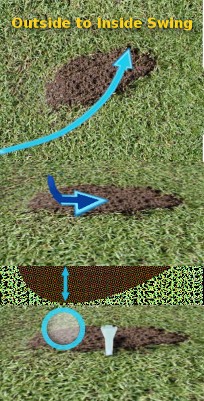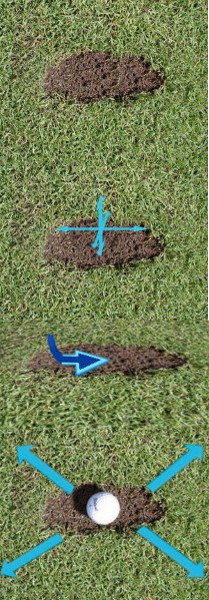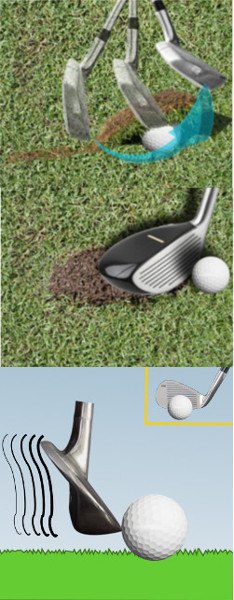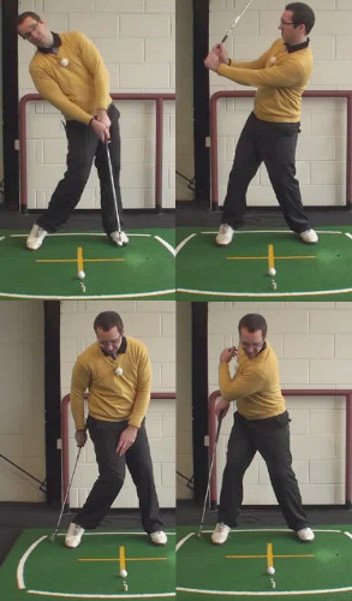
Learning the game of golf is very much a trial and error process. GolfInfoGuide.com and other material or instructors are there to help you along the way but the learning process is still mostly up to you. Because of this, it is important to take notice of any good feedback you can get when practicing and playing.
One good piece of feedback to pay attention to in your game is your divots. A simple way to check your divots is to see if they line up with your target. Divots also leave some vital clues as to possible flaws in your swing mechanics.
- Divots can show you your swing path direction during impact. If the divot's direction points to the left then you know that your swing path during impact was out to in and of course if the divot points to the right, your path was inside to out.
- The divot can also show you if your clubs are fitted properly. For instance if the divots are deeper towards the part of the divot hit with the toe of the club then you know that you need your lie angle bent upright to better match your impact position and swing.
- The depth of the divot can tell you how steep or shallow your angle of attack is. Different shots call for different swing angles; for instance, if you are hitting a high spin wedge shot then you want some depth in your divot but if you're hitting your hybrid then you should be looking for more shallow divots.
- You can probably tell from the feel and sound at impact whether or not you hit the ball solidly but you can certainly see from the divot where the club first entered the ground in relation to where your ball was. To test it out, you can place something like a tee aligned outside the ball to measure your divots entrance and where the ball was. The divot should, of course, follow just past where the ball was and point towards the target. With some advanced players, since the swing is along an arc, you can even see the divot start out straight and then curve towards the left at the end of the divot.

What You Can Tell from Your Divots
It is easy to overlook your divots. After all, they are just chunks of grass that are unearthed when you swing your club down into the ground. Once they are either replaced or filled with sand, you move on and never think about them again. But should it really be that simple? Maybe not. For the golfer who wishes to get the most out of his or her game, adivot can actually be a valuable piece of information that can provide feedback about the swing that just took place. By learning how to 'read' your divots properly, you stand to make major improvements in the way you swing the club as you go around the course.
You can think of your divots as something similar to the fingerprints that are left behind after a crime has been committed. Police investigators will look for fingerprints as a clue when trying to solve a case, and you can look at your divots in much the same way. By analyzing the characteristics of the divot that you have taken out of the turf, you can determine a number of important things about your swing. The conclusions that you draw based on your divots should help you understand why the ball flew in a certain direction, and what you can do next time to correct any errors that may have occurred.
Many golfers overlook their divots because they don't understand just how important they are – but others do so out of sheer laziness. It is easy to hit your shot and just start walking down the fairway or back to your cart, but doing so will mean you are missing out on an important opportunity to get better. It will only take a couple of seconds to learn from your divot, and that information has the very real potential to save you strokes later in the same round. You obviously don't want to hold up the pace of play while checking out your divots, so just take a quick look and get moving.
Of course, you aren't going to take a divot on every shot that you hit, so you will want to take the opportunity when you do carve out a divot to learn about your swing. Driver shots that are played from the tee are unlikely to lead to a divot – in fact, something is surely wrong with your technique if you are regularly taking divots with the driver. Also, long iron shots may not produce divots, and you could have trouble taking a divot with any club if you are playing on a course that is dry and firm. Most players will consistently take divots on mid and short iron shots, especially when the course conditions are relatively soft.
All of the content below is based on a right handed golfer. If you happen to play left handed, please take a moment to reverse the directions as necessary.

Three Divot Characteristics
There is an art to learning how to read a divot. Just as a police investigator needs to know how to read and analyze a fingerprint, you need to understand what to look for in a divot so you can draw the correct conclusion about your swing. This process might seem a little bit intimidating or overwhelming at first, but it is actually quite easy once you have some practice under your belt.
In general, there are three divot characteristics that you should be looking for each time to take some turf out of the ground. Those three points are as follows –
- Direction. This is the first, and most obvious, point that you should be checking when you evaluate your divot. Look at the hole you have created in the ground and determine which direction the club was traveling as it moved through impact. Was the club head swinging directly down the target line, or was it moving to the right or left? How does this match up with what you intended to do with the shot? For example, if you were intending to hit a draw – which would require a divot pointing out to the right of your target line – but the divot is pointing left, you will know something went wrong. While you aren't going to be able to keep your divot moving directly down the target line each and every time you hit a shot, it is important to monitor this point to make sure your technique isn't getting too far off track. If you are regularly producing divots that are dramatically off line, you will know there is a problem within your swing mechanics.
- Depth. This is a point that is often overlooked when divots are analyzed. Not only should you be checking on the direction of your divot, but you should check on the depth as well. A shallow divot means that the club was coming into impact on a relatively shallow angle of attack, which a deep divot means that you were attacking the shot from a steep position. There isn't necessarily a right or wrong on this point, as you can hit good shots with either a shallow swing or a steep one, but the divot should match up with what you were trying to do. For instance, if you were trying to hit aggressively down through a short iron to create plenty of spin, you should find a deep divot after the shot has been struck.
- Entry point. The final element of your divot that you should check on after your swing is the shape of the divot itself – specifically, the shape of the divot at the point where the club entered the ground. Does the divot start off with a clean, straight line at the back, or is it angled in from one side to the other? Checking on this part of the divot will tell you if the club was square to the ground when you reached impact, or if the toe or heel was leading the way. Players who have flattened out their swing on the way down will usually put the toe into the ground first, often leading to a hook. On the other hand, if you come into impact on a steep plane after making an over the top move in the transition, the toe will find the turf before the rest of the club head. When that happens, a big fade or a slice is almost certain to result. If you are going to achieve consistently solid ball striking round after round, you want to make the entry point of your divots as clean as possible.
Only when you are able to analyze all three of the points listed above will you be able to really understand what your divots are telling you about your swing. Looking at just one or two of these elements would be like using only part of a fingerprint at a crime scene – it would not tell you the whole story. It might seem like a big challenge to use all of this information to evaluate your swing, but you will quickly become comfortable with the process after just a bit of practice.

Fat or Thin?
One of the basic elements of good ball striking is simply hitting the ball cleanly as you move through impact. This is a relatively easy challenge when playing from the tee, but it becomes much more difficult out of the fairway. You will never be able to hit all of your shots cleanly – even professional golfers miss the ball fat and thin from time to time – you should be working toward limiting the number of mistakes you make in this regard. If you can hit the ball cleanly more often than not at impact, you will have an easier time predicting the distance that the ball will fly in the air – meaning you will be able to get closer to the target when all is said and done.
While an experienced golfer will immediately be able to feel whether they hit the ball fat or thin, you might not have that same feel in your hands just yet. If that is the case, you can use your divot to tell you if the shot was struck cleanly, or if you missed it slightly. This is actually quite simple to do, using the guidelines below –
- If your divot starts before the position of the ball, you will know that you have hit the shot fat. The impact with the ball usually feels 'heavy' when you miss in this manner, and the ball will almost always come up short of the target. In fact, if you hit the shot extremely fat, you might find that it only travels a few feet in the air. Hitting the ball fat on a regular basis is a sure sign that the bottom of your swing needs to be moved to the left in order to find the ball prior to hitting the turf. Many people who fight fat shots struggle with their balance, as they lean back away from the target at some point during the backswing or downswing.
- If your divot starts well beyond the position of the ball – or you don't take any divot at all – there is a good chance you hit the shot thin. Thin shots will usually cause the club to vibrate badly in your hands. On a cold morning, you might even find that it hurts to hit the ball thin, as the vibration sent up through the shaft and into your hands can be quite painful. Shots that are only slightly thin will lack a bit of backspin and won't climb as high into the air as a clean shot. Extremely thin shots, however, will shoot off of your club and fly just a few feet off the ground. The ball will have effectively no spin, and it will likely bounce and roll out of control when it does come down. Neither a fat or thin shot is going to be ideal, but it is usually the thin shots that cause more damage simply because of the way the ball can careen out of control across the course.
As you gain experience on the course, you won't even need to look down at your divot to decide if you hit the ball fat or thin – you will be able to feel it in your hands as soon as you reach impact. Until you gain that experience, however, you can use your divot location as a great indication of the quality of contact that you achieved. Use the information you gain from watching the position of your divots to make adjustments to your swing as necessary. Hopefully, after a short period of watching your divots, you can make corrections that greatly reduce the number of fat and thin shots you hit.

A Divot Free Game
If you are a golfer who never takes a divot – even after hitting a short iron – you should consider taking a close look at your technique to see what might be going wrong. You certainly don't need to take a divot on every shot that you hit, but never taking a divot is a sign that there is a fault somewhere within your mechanics. Getting that fault fixed to where you can take a divot from time to time will make you a better ball striker in the long run.
Most players who struggle to take a divot are dealing with balance problems. When the golf swing is well-balance, the center of your body will remain over the ball and your swing will bottom out just after impact. However, when your balance is lost and your weight moves all around during the swing, there is almost no way to predict where the swing will actually catch the turf. Balance is one of the most important fundamentals in all of golf, and it certainly has a lot to do with your ability to make clean contact prior to tearing a divot out of the ground.
The first thing you should work on if you would like to learn how to take divots is your takeaway. Often, the average golfer loses his or her balance as soon as the takeaway begins, and the swing goes off track from there. As you start to move the club back away from the ball, focus on keeping your knees in position while your shoulders turn away from the target. When it is done correctly, the takeaway feels extremely simple – almost too simple. You don't really have to do much during the takeaway phase of the swing, other than turn your shoulders while holding the rest of your body still. If you can avoid getting pulled off balance during this critical first phase of the swing, you will have a great chance of staying on balance the rest of the way.
Another point that you need to watch when it comes to your balance is the transition from backswing to downswing. Many players who struggle to take a divot lose their balance at this point by leaning back away from the target. The thinking makes sense to some degree – the player leans back to the right in an effort to 'scoop' or 'help' the ball into the air at impact. While players who struggle with this mistake are well-intentioned, they are missing an important point that makes this kind of lean unnecessary. Since your clubs all have some degree of loft, the club doesn't need any help getting the ball up into the sky. All you have to do it hit down through the shot aggressively – the loft of your club will take care of getting the ball off the ground.
So, when you are transitioning from the backswing to the downswing, your goal should be the same as it is when getting the swing started – to keep your balance under control. You don't need to lean back during the transition, but you don't need to lean forward either. Quite simply, you want to stay over the ball throughout the swing, so that your body is in a powerful position to strike when impact arrives. Anything that affects your balance in a negative way should be taken out of your swing, as there is no move within your technique that is important enough to exchange for balance. If you watch golf on TV, you will notice that the best players in the world all put a premium on staying balanced while they swing – you should follow their lead.
If you are able to stay balanced as you swing the club, you will find that it becomes rather easy to take a nice divot. As was mentioned earlier, you aren't going to take a divot on all of your swings, nor should you. You will likely take divots from the ground when you hit short iron shots, and maybe on your mid iron shots as well. However, with a driver or a long iron, you could find yourself missing the grass entirely. The key here is to focus on balance – as long as you are balanced, you can feel good about what you are doing with the club.

Short Game Divots
Can you take divots when you are playing short game shots? Of course! You obviously won't be taking the same large divots that you might take when hitting a full shot with a short iron, but you can definitely take some small divots while playing pitches and chips from around the green. In fact, it is important that you take a divot when you play short wedge shots that you expect to stop quickly thanks to plenty of backspin. Short shots that lack a divot aren't going to have very much spin, and they will be hard to control as a result.
There are two general categories of chip and pitch shots that you can play from around the greens – bump and runs, and chip shots that stop with spin. When you are going to play a bump and run, you will largely want to avoid taking a divot, as you are going to hit through the ball on a shallow angle of attack. That shallow angle will prevent a high spin rate, meaning the ball should bounce and roll out nicely toward the target. There is nothing wrong with that kind of shot, but it is only going to work some of the time. For those times when you want to stop the ball quickly with plenty of spin, it is going to be necessary to take a divot. As you hit down through the ball and into the turf, there will be a high rate of backspin passed to the ball, and the shot should stop fairly quickly after a bounce or two.
It is extremely important that you find a way to take divots on your 'mid-range' pitch shots – ones that are played from 30 – 50 yards. This is a range that gives many golfers trouble, and the problems usually start when the player tries to lift the ball up into the air. You really have to trust that the loft of your wedge is going to give you the air under the ball that you need for this kind of shot. Hit down aggressively, take a divot from the turf, and watch the ball land safely on the green before stopping quickly thanks to the high spin rate you have achieved.
You can learn a lot from your divots, but you have to know what you are looking for – and you have to be paying attention. Hopefully the content above will help you understand how divots can show you what is going on with the club as it moves through impact so you can make adjustments as necessary. During your next round of golf, make it a point to check out your divot after each shot and you just might be surprised at how much it can help your performance.






